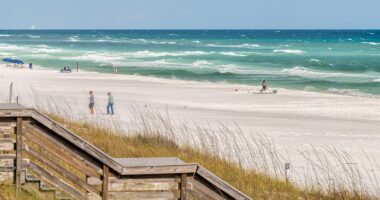LOS ANGELES — An exceptionally high number of marine animals, particularly dolphins, are perishing as a result of a toxic algae bloom that is currently spreading from San Diego to San Luis Obispo. The entirety of the coastline is considered extremely hazardous due to the presence of a neurotoxin known as domoic acid or DA.
This is the fourth year in a row that this has happened, and experts say this is the worst yet.
Data from the Southern California Coastal Ocean Observing System illustrates the significant concentration of domoic acid in the heart of the toxic algae bloom that is now overwhelming the Southern California shoreline and causing widespread animal casualties.
“This is the most severe situation we have ever encountered in Southern California on multiple fronts, with dolphin strandings being particularly unparalleled,” stated John Warner, the Chief Executive Officer of the Marine Mammal Care Center in Los Angeles.
In the past week, there have been more than 50 dead and dying dolphins found along the L.A. County coast. There were 16 in San Diego on Sunday alone.
“It’s really been consistently severe, the number of animals coming up on the beaches, either with seizures or dead or dying, has continued at a pretty high rate,” said Michael Milstein with NOAA Fisheries, West Coast Region.
Sea lions are traditionally the main victims of a toxic algae bloom, which can cause them to turn aggressive and attack beachgoers. But now, the toxic algae bloom is moving further up the food chain.
READ MORE: Aggressive sea lion caught on video at Newport Beach euthanized after chasing surfers
Shocking video shows an aggressive sea lion actively going after people in the water and on shore. Experts say a toxic algae bloom in the water is making marine mammals sick and changing their behavior.
Researchers say a minke whale found in the Port of Long Beach and a young gray whale in Huntington Beach both died due to domoic acid toxicity.
“It is a natural phenomenon that happens because of offshore winds, cold water upwelling, but it can be fed and sort of put on steroids by the things we’re doing,” Warner said.
Debris from the wildfires and fertilizer runoff are helping to fuel the toxic algae, which are eaten by small fish, which are then eaten by marine mammals and birds, causing a potentially deadly toxic overdose.
While sea lions and birds can be saved, it is 100% fatal for dolphins.
As researchers are sounding the alarm, they are also holding hope that the beloved animals won’t suffer any long-term damage.
“We know these populations are resilient, strong and can bounce back from this relatively quickly, provided they have the food and other resources they need,” Millstein said.
At this point, experts say they see little hope for immediate relief given how widespread and well-fed the algae bloom is.
Copyright © 2025 KABC Television, LLC. All rights reserved.

















